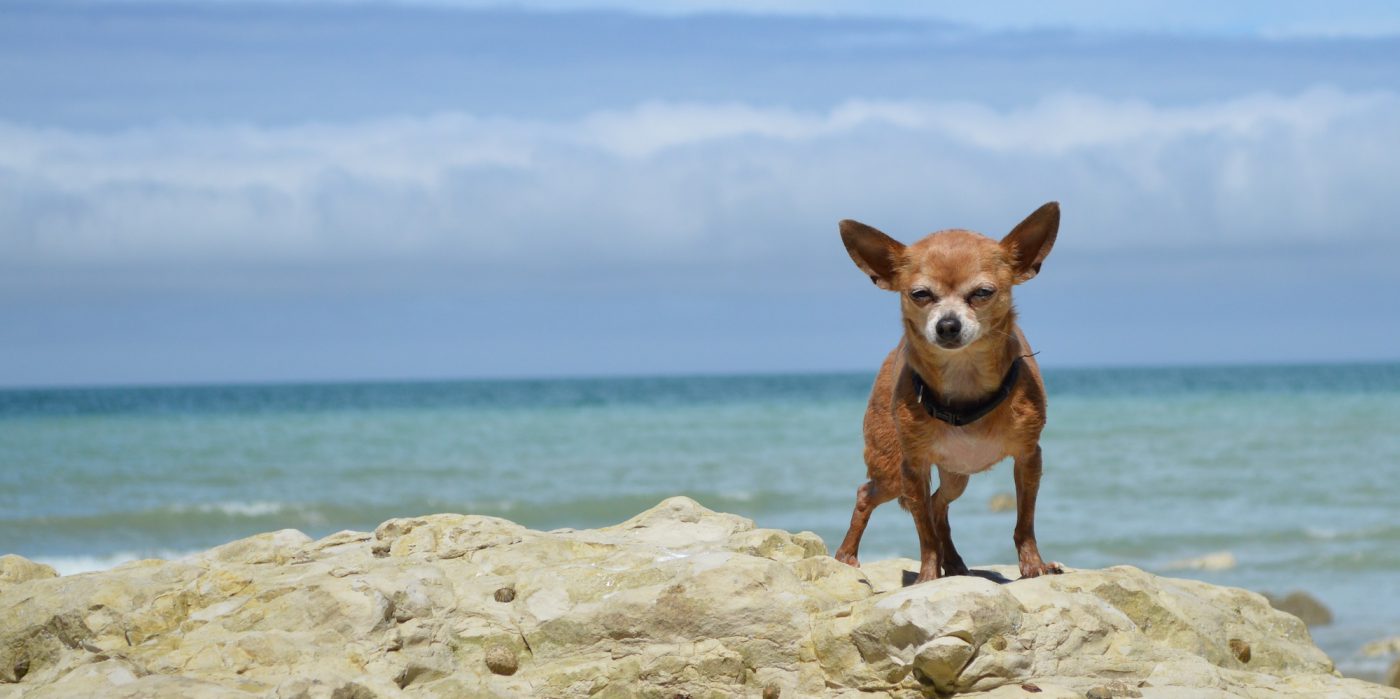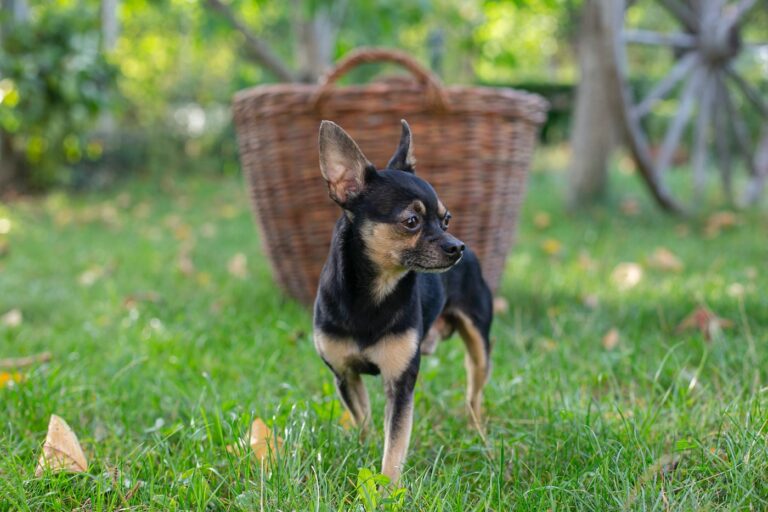Though small in stature, the Chihuahua looms large in popular culture, and in the lives of the dog lovers who share their homes with this tiny titan.
While many famous Chihuahuas, like Elle Woods’ companion Bruiser, are known as fashionable sidekicks, Chihuahuas aren’t just accessories—they demand as much care, attention, training, and mental stimulation as any dog. Read on for what you need to know to have a happy, healthy, harmonious, and possibly hilarious relationship with a Chi or Chi mix.
Basic Chihuahua breed facts
Chihuahuas can weigh from just two to eight pounds (though they typically top out at six pounds) and stand from about five to nine inches tall. Chihuahua mixes can also be teeny tiny, but can get up to about 25 pounds depending upon the other varieties in their DNA.
Chihuahuas can be short-haired or long-haired, with a range of coat colors, but they all tend to have big, luminous eyes, and large, erect ears (known as bat ears). They typically don’t require a lot of grooming and tend to be very clean pets in general, says Tamie Parker, director of Texas Chihuahua Rescue.
Like other smaller dogs, Chihuahuas typically live longer than average lives, with a lifespan that can reach 14 and even up to 18 years. Parker urges prospective pet owners to think of adopting a Chihuahua as making a 20-year commitment. People may bring a Chihuahua home without factoring in future changes in their lifestyle, and the demands of keeping this pint-sized pup happy. As with other breeds, some pet owners are drawn to their looks only—in the case of Chihuahuas, they may be attracted to their size, and to the idea that they’re so small that they’re low-maintenance. This is hardly the case! Chihuahuas require just as much care and training as a larger dog.
These factors lead to many owner surrenders—Chihuahuas are now, sadly, one of the most common breeds in shelters.
If you have your heart set on a Chihuahua be sure to put in the time to train your Chi to be happy, balanced, and respectful of all family members (more about that below). Parker also recommends adopting a Chihuahua mixed breed. “These pets are a bit heartier, typically within the 10-12 pounds size range. They are still little, but tend to be more easygoing and have fewer health issues.”
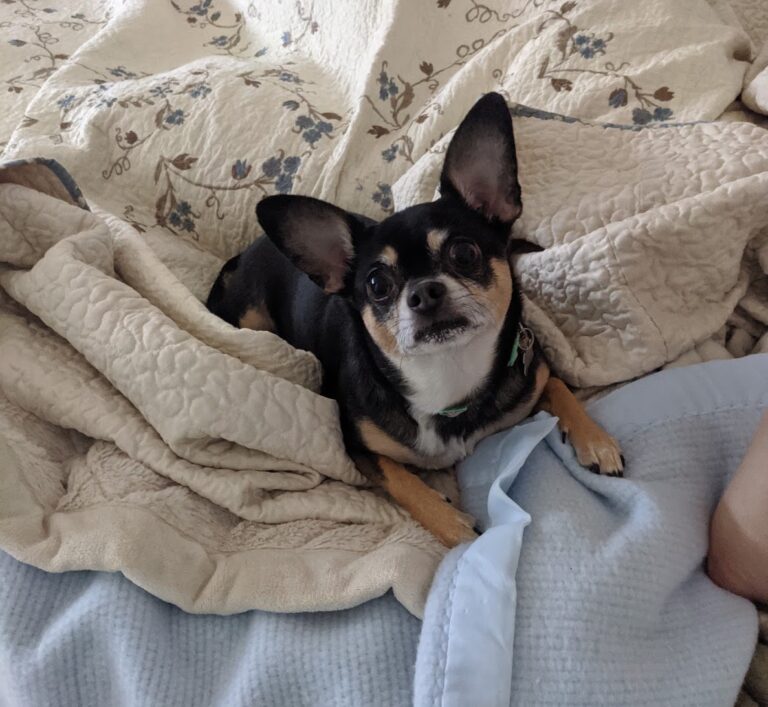
Sofee
The chihuahua typical personality profile
Although they’re the most diminutive of all the dog breeds, fans of Chihuahuas (and even their detractors) will tell you their personalities are anything but small. Chihuahuas are described as “terrier-like” which provides a clue to their typical disposition. These adorable dogs often have charmingly outsized temperaments that can range from opinionated and bossy to sweet and cuddly.
Chihuahua-loving dog owners describe the breed as being feisty, sassy, scrappy, emotional and loyal (it’s worth noting that they are described in the AKC breed standard as “saucy”). These “perfect little specimens” as one Chi owner put it, are loyal to their core—and that’s one attribute everyone seems to agree on.
Their loyalty tends to make Chihuahuas protective of their humans and suspicious of strangers. This can make them surprisingly effective watch dogs.
Emily Smith, mom to Chihuahua Sofee, describes her dog as very loving to those she is close to. “She greets every person that enters the house one of two ways: either barking to alert us there’s an intruder or bringing them her favorite toy and trying to hug them once they sit down. Chihuahuas are known to be pretty dramatic and she definitely fits that character.” Brittany Lechlinski, mom to “Chug” (Chihuahua/Pug mix) Myla describes her dog as “stubborn and bossy and sassy.”
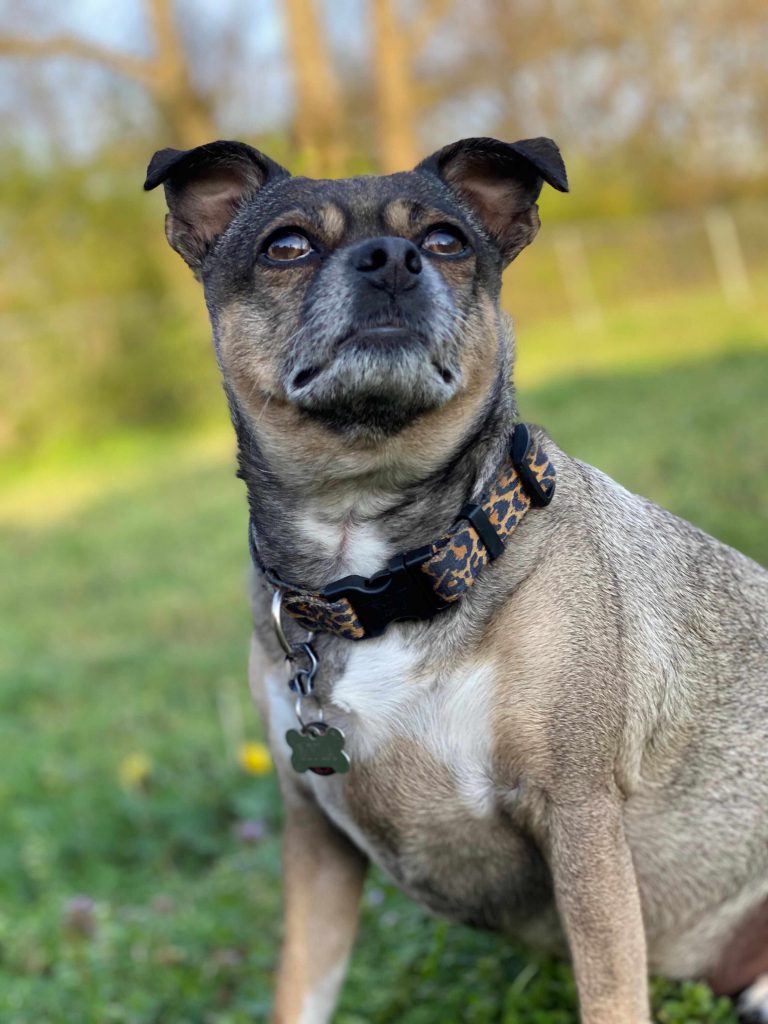
Myla
Breed history of Chihuahuas
Chihuahuas are named after the Chihuahua state of Mexico. Studies support a native Mexican origin as the dogs’ lineage can be traced back thousands of years to pre-Colombian civilizations that make up present-day Mexico. There are also artifacts depicting Chihuahua-like dogs at various archaeological sites.
Some historians theorize that Chihuahuas are descendants of a dog breed called the Techichi, companion animals raised by the ancient Mesoamerican Toltec civilization. The later Aztec civilization may have raised Chihuahuas to be used as food, as suggested by Spanish explorer Hernán Cortés in a 1520 letter to King Charles V in which he recounted many details of his experience with the Aztecs. Cortés wrote that the “little dogs” were “raised for eating,” along with other animals he saw for sale, including deer and rabbits.
The number of dogs declined after Spanish conquest of the Aztecs, but began to experience a revival in the 1800s when Americans started to take an interest in the breed. The Chihuahua dog breed was officially recognized by the American Kennel Club in 1904, and their popularity grew along with the trend to urbanization in mid-century as people sought out dogs who could thrive in smaller spaces. They’ve remained among the most popular breeds since.
Healthy Lifestyles for Chihuahuas
Lifestyle & home
Chihuahuas were bred for hot climates, so they can get cold very easily—hence the disproportionate sweaters-to-Chihuahua ratio. That trademark Chihuahua shiver typically means they’re cold! Make sure your dog has a warm resting place with some blankets to burrow into. Be careful with your Chi outside—limit the amount of time they’re spending outdoors in cool or cold weather and never leave them outside.
With their small stature, Chihuahuas can be easily mishandled and hurt—trauma is one of the leading causes of death in this breed—so interaction with other dogs, children, and careless adults should be supervised closely to avoid accidental injury.
Chihuahuas’ size also means you can bring them anywhere, which is a plus for Chi owners, and can make for good opportunities for socialization for puppies. But be sure that you’re also allowing your pup to walk.
Many people might assume that the little Chi doesn’t need exercise, and will be content being carried around. But Chihuahuas have quite a bit of energy, and like any dog, they need to get out and walk for mental and physical exercise. You can start with about 30 minutes a day and see how they react, keeping an eye out for signs of overexertion. Chihuahuas can be prone to being overweight so exercise and food-portion control are important. “Exercise is super important!” says Nat Correa, mom to long-haired Chihuahua Tuco. “My Chi goes on 10-15 minutes walk two to three times a day,”
Physical exercise and mental stimulation will keep your Chi healthy, and along with training, will help ward off some of the more notorious breed behaviors.
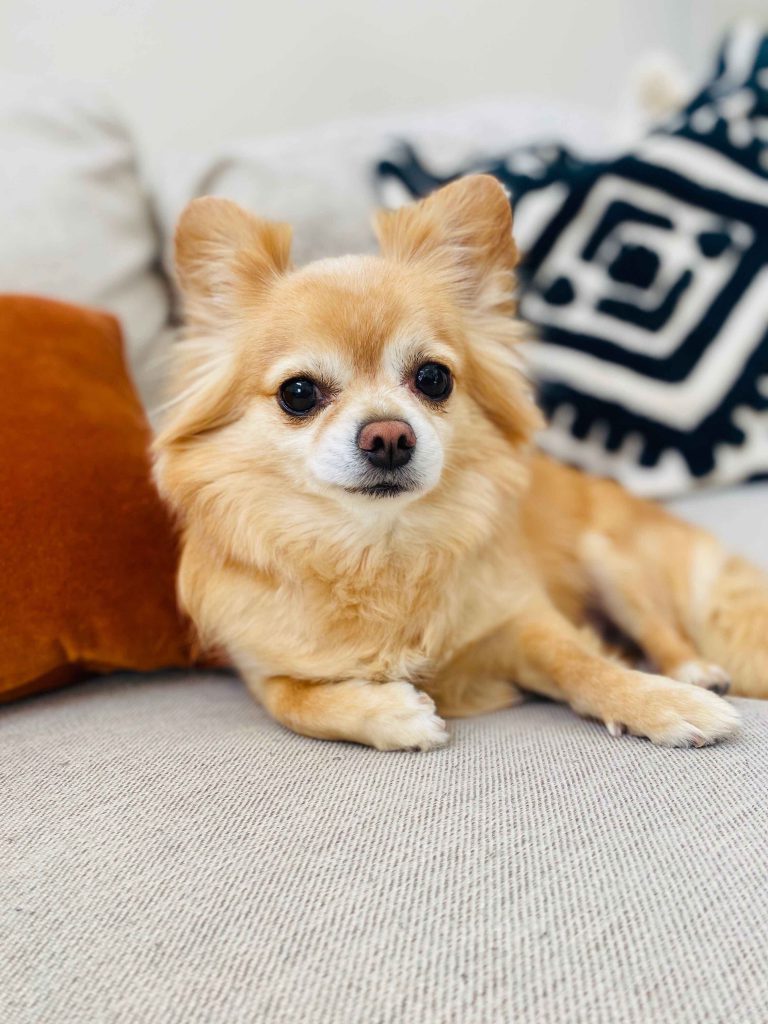
Tuco
Training and behavior
People can sometimes apply a different set of rules when it comes to small dogs and training. When they have a bigger dog, people are more regimented with training, Parker notes. But dedicated, ongoing training is essential to keep your Chihuahua’s big personality from becoming tyrannical.
Chihuahuas are known for a number of trademark behaviors—some of which arise from real Chi tendencies, and some of which may be the mark of a lack of training and boundary-setting (and some involve a bit of both).
They’re known for their loud, high-pitched bark (the Chi owners quoted in this article answered a hearty “yes” when asked if their dogs are prone to barking). As noted, these little dogs can be quite protective, so they can tend to bark at anyone or anything perceived as an intruder. But, often, excess barking in Chihuahuas arises from the same factors that can lead to barking in other dogs, which can include boredom and lack of physical or mental stimulation, or separation anxiety. It’s important to examine the root cause of the barking, and ensure you’re not unwittingly rewarding it. And, as with any breed, make sure your Chihuahua is getting plenty of brain-taxing activities and exercise.
Chihuahuas are also somewhat notorious for being nippy towards, or disliking children.
While any dog, including a Chihuahua, can be trained to coexist with young kids, it’s true that Chis are not the breed most associated with carefree, low-maintenance canine-toddler relationships. If you are considering adding a dog to your family, and your first priority is rough-and-tumble kiddie companionship, a Chihuahua may not be your first choice. These small dogs can be intolerant of small people who may act erratically, and with their tiny frames, Chihuahuas are delicate and are easily injured by rough handling. If you have children, it’s essential that both dog and children are trained in appropriate interaction. If your kids are old enough to understand, teach them the proper way to pet and handle the dog.
“They are dogs that get treated differently than the average pet dog.”
Relatedly, Chis are known for being a “one-person” dog. Fiercely loyal to their owner, they can develop strong, protective bonds with a primary guardian. This can make them lovely companions, but as with any dog, if their natural tendencies aren’t channeled in a positive direction, it can result in unwanted behavior.
All this said, Chihuahuas CAN be a family dog like any other, if they are taught to respect boundaries and space.
The Chihuahua stereotypes—barky, aggressive, overprotective, bossy—are often nurtured by their humans, says Blake Rodriguez, trainer and founder of Dream Come True K9 in New York. “Sadly, due to their size and being positioned as dogs that are great for apartment living, fitting in purses, and not needing a lot of exercise, they tend to be dogs that don’t get fulfilled the way that ALL dogs need to be. They are dogs that get treated differently than the average pet dog.”
The Chihuahua is a naturally large character, and when that character meets a lack of exercise, structure and training, says Rodriguez, the dog can get bored, frustrated—and bossy.
“If you give the Chihuahua regular exercise (both mentally and physically), routine structure and boundaries, you’d see a dog that could thrive around children, other people, and dogs, and enjoy the comfort of the couch and the lap on the human’s terms,” says Rodriguez. “Rules help them feel like they have something to follow and a job to do. It balances them.” As all Chi lovers agree, these dogs are loyal. This also means they’re loyal to their habits, says Rodriguez. “We have the ability to shape and reinforce the habits that we want them to become loyal to, or they can become loyal to the habits that give them a bad rep which, in my opinion, is super unfair.”
Here are a few things can help make your Chihuahua a family-friendly dog:
No “cute excuses:” It’s easy for dog owners to write off bad behavior as cute, or “sassy,” when it’s coming from a pint-sized pup. But these behaviors can turn into big problems if they’re not addressed. And some owners can be unwittingly reinforcing behaviors if they’re simply picking up or consoling or giving their dog attention when they act up. Especially since Chihuahuas tend to live on shared elevated platforms, like beds, couches, and people’s laps, without the necessary training they become overprotective, possessive, and territorial, says Rodriguez.
No dog should be allowed to nip at or bite a child (or anyone else). Treat your Chi as you would a pit bull—that means taking warning signs and bad conduct seriously, and engaging in consistent training and boundary-setting.
Ample socialization: When you’ve got a coat-pocket-sized dog, it’s tempting to keep them comfortably cocooned away from the world, but it’s important to carefully offer your Chihuahua lots of exposure to not just other dogs, but people, places, and things. Properly socializing your puppy, or your older dog, can make a big impact on their behavior long-term. If you have a puppy, it’s a great opportunity to start strong, with early socialization which will make them familiar and comfortable with a range of stimuli, and reduces their chance of becoming excessively fearful, anxious, and potentially aggressive.
Sharing dog-care and training duties: If your Chihuahua is exhibiting some classic “one-person dog” tendencies, keep an eye on just HOW attached they are to that person. Many dogs have a particularly strong bond with one person, which can be fine. If that bond starts tipping over into disrespectful or aggressive behavior towards other family members or others who come into the home, some focused training and changes in routine might be needed. Each family member (who is not a very young child) can take a role in training and reinforcing good behavior day to day by running through basic commands, and controlling space—only allowing the dog to enter a certain area, or jump on furniture, for example, when given permission, and never responding to bossy behaviors like barking for attention. Family members should also share walking duties —making sure they’re setting the pace and the dog is showing good leash manners—and take turns feeding, ensuring that food is only given when the dog has followed the “wait” command.
Again, it’s important to not just tolerate even tiny attacks aimed at family members. If your Chihuahua is constantly nipping or actually biting any family member, consult a professional trainer. And be sure to supervise kids and dogs at all times.
Breed-specific health concerns
Chihuahuas are a fairly healthy breed, but their human companions should keep an eye out for the following health and safety concerns:
Injury around the house: Chihuahuas’ tiny size puts them at greater risk of injury from larger creatures and moving objects, including owners accidentally sitting or lying down on their dog. With these devoted nestlers and burrowers, it’s important owners check blankets and stray clothing before plopping down. Careful supervision around children, larger dogs, new people, and loose large objects is important, too.
Dental issues: A standard Chihuahua was typically seven pounds, but over the years they have been bred in order to create very small dogs. And while breeders were able to make some Chihuahuas smaller, they don’t have fewer teeth. So, Chihuahuas can be prone to overcrowding of teeth and subsequent dental issues, such as malocclusions (or crooked teeth), and periodontal disease.
Epilepsy: This neurological hereditary condition can cause seizures. They generally aren’t painful, but may need to be treated with medication. Chihuahuas with epilepsy can often continue to live long, happy lives.
Tracheal collapse: This condition isn’t completely understood, but Chihuahuas are at a congenital risk for it, especially as they age. It causes difficulty breathing and sometimes causes “goose honk” coughing. Although there is no way to cure a collapsing trachea, generally dogs treated medically showed positive, long-term responses.
Heart disease: Chihuahuas are prone to heart valve issues (mitral valve disease) which can cause heart failure later in life, as well as patent ductus arteriosus, a heart deformity.
Knee problems: Chihuahuas are prone to patellar luxation, or having loose kneecaps. This can cause frequent dislocations and may result in arthritis. Many Chihuahuas can live normally with luxating patellas. But if there is a traumatic event or over-exertion, they may develop severe and permanent patellar luxations, and need surgery to correct them. Issues like this are one reason it’s important to keep your Chihuahua at their ideal weight.
Pregnancy complications: As a breed with a relatively large head and narrow pelvis, it’s very common for Chihuahuas to require C-sections to give birth, to protect both the mother and her puppies.
Nutrition
Very small fluctuations in meal size (differences you may not even notice by “eyeballing” the bowl) can have a huge impact on your Chihuahua’s weight. As in humans, obesity in dogs contributes to a higher risk of many serious health conditions. And it doesn’t take much excess weight—especially in small dogs—to trigger health issues. In Chihuahuas, excess weight can aggravate the knee problems they are prone to.
Since it’s very easy to overfeed or under-feed a Chihuahua without realizing it, it’s important to determine the precise number of daily calories they need and keep track of their weight and body condition. (see the body condition guide here). And keep an extra close eye on treats, which can really add up and contribute to weight gain and nutritional imbalance in a tiny dog.
Many Chihuahua owners worry that their dogs are picky eaters or not eating enough due to their small portion sizes. However, while their meals look tiny to us, the proper daily calorie intake for a Chihuahua is minimal, possibly just 200 calories, depending on their size and activity level.
If you’re looking for pre-portioned, healthy meals, tailored to your Chihuahua’s age, size, activity level, and weight, you can consider signing up for a fresh food plan. A plan tailored to your pint-sized pup will take the guesswork out of portion management, and ensure you’re providing all the necessary nutrients, in the right balance. A healthy diet is the best way to support your Chihuahua’s health and happiness — along with training, regular vet care, love, playtime, and a wardrobe of stylish sweaters, of course.
If the Chihuahua breed sounds like the perfect loyal companion for you, consider adopting from a local Chihuahua rescue or animal shelter. The Texas Chihuahua rescue cares for about 100-120 dogs at a time and facilitates about 1000 adoptions a year. If you’re in the Texas area, check out the adoptable dogs that Parker’s rescue has available at their website.
Pet health is an important topic. That’s why The Farmer’s Dog editorial team carefully vets and reviews every piece of content we publish. We deliver evidence-based advice and medically reviewed facts that focus on pet nutrition, health, and well-being. The mission of this site is to help people provide the best care possible for their dogs by publishing only trustworthy, accurate, and timely health information from a group of passionate experts.
This article was vetted by a vet.
Reviewed by Melanie Shapiro, DVM.



